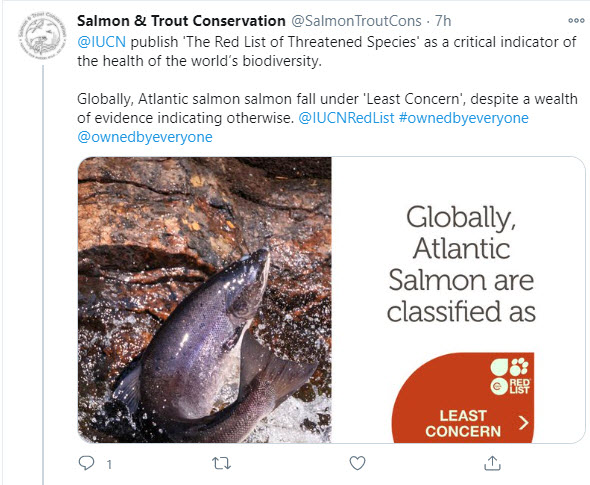REC Committee: Like many others, I watched the REC Committee with interest. I shall however wait for the meeting record to be published before making any comment.
Science led?: S&TC have always claimed to be strong on science so it was interesting to see that on Thursday, they tweeted the following:
IUCN publish ‘The Red List of Threatened Species’ as a critical indication of the health of the world’s biodiversity. Globally Atlantic salmon salmon (sic) fall under ‘Least Concern’ despite a wealth of evidence indicating otherwise.’
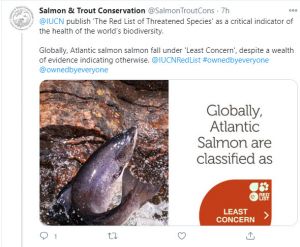
It is unclear as to the purpose of this tweet. Are they saying that wild Atlantic salmon are more endangered than ICUN suggest, but surely if that is the case, then why are S&TC not demanding an end to the killing of wild salmon for sport?
The real problem with their tweet is that S&TC have not done their research. Atlantic salmon were of ‘Least Concern’ back in 1996, but the list was reviewed in 2014 when Atlantic salmon were reclassified as ‘Vulnerable’, one step from being endangered.
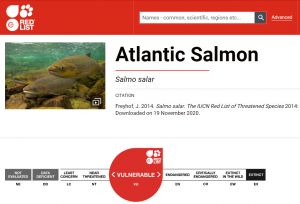
ICUN usually review the list every six years so another review is forthcoming. The Twitter feed @TalkSalmon points out that animals classified as endangered cannot be legally caught. Could it be that we are not that far away from the end of fishing for salmon?
Their reference to ICUN confirms that S&TC are living in the past because as we know, their view of salmon farming also dates back to the 1990s.
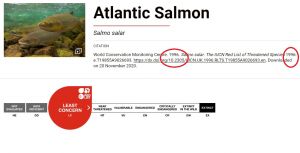
It’s good to talk: Regular readers will know that over the years I have tried to speak to Andrew Graham Stewart of Salmon & Trout Conservation Scotland about his campaign against Salmon farming. He has never acknowledged any of my attempts to reach out to him. I suppose he could argue that I am not an official representative of the salmon farming industry and he would be more prepared to engage with the industry instead, although I have never heard of any such discussions.
Salmon & Trout Conservation recently posted their 2019 accounts for the Charity Commission. There is much to discuss in this document. However, what caught my eye was reference to a Fish Farming Coordination Fund. This was specific funding to cover the costs incurred by a group set up to co-ordinate negotiations with salmon farmers.
This would be a definite positive step for S&TC. They cannot campaign against the salmon farming industry for ever without eventually having to engage in face to face discussions. The funds provided amounted to £2,349 and were donated by the Fishmongers Company.
This was in 2019 so what happened to this group as it is something that has not been publicised? The answer is simple. The group was not formed as it seems that S&TC preferred to continue to avoid having to discuss the issues with those they claim are the problem.
The report states: With the agreement of the original donor, £2,349 was transferred from Fish Farming Coordination to Aquaculture Campaign/Salmon Farm Reform.
No data: The latest issue of Country Life magazine includes the now traditional birthday leader by His Royal Highness the Prince of Wales. The theme is ‘we should not betray nature’ and the nature includes mention of wild salmon. He writes that:
“There is only now a fifth of the population of wild salmon returning to UK rivers compared with the 1980s. This is why I am so pleased that the wild fish conservation and commercial aquaculture sectors have been working together in Scotland to understand and address the alarming decline of this ‘beacon species’.”
Given that the Prince of Wales is a patron of Salmon & Trout Conservation, his comments should come as no surprise, especially as he describes the angling sector as that of wild fish conservation. Yet, I can still shake my head in disbelief after reading his comments. The implication is clear, that salmon farming is instrumental in the decline of wild Atlantic salmon. What is most saddening is that the 40,000 people who read this magazine will think that because it is the Prince of Wales who has written this, it must be the truth.
I don’t know how many times I have highlighted that it would be good to see a bit of real evidence that the salmon farming industry is responsible for the declines of wild salmon and sea trout, but for some reason, whilst the wild fish sector are quick to condemn the industry, they are extremely reluctant to provide anything but the most tenuous circumstantial evidence.
Instead, as we have seen through the REC Committee inquiry, there are ever increasing demands that the salmon farming industry should become even more transparent by publishing the most detailed data possible and in real time. However, I would argue that such data is almost meaningless unless it can be applied to what happens to wild fish. For example, if salmon farms can reduce their sea lice count down from 5 to 0.5, then how many fewer wild fish will die?
The salmon farming industry has now been operating for nearly fifty years, so surely someone must be able to link what happens on a farm to what happens to wild fish or the other way round. The reality is that the wild fish sector has not made much of an attempt to verify its claims. The scientific paper by Butler and Walker (2006) is the likely source for the wild sector to blame salmon farming. This paper links the arrival of salmon farming in Loch Ewe to the collapse of the Loch Maree sea trout fishery as is made clear by their graph.
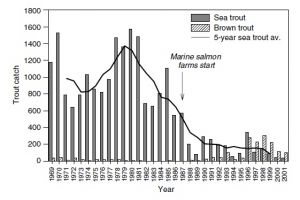
Thirty years on from the collapse of Loch Maree sea trout, the ability to link salmon farming to wild fish declines has not improved. I have yet to see evidence that any farm is directly responsible for a decline in stock in any river. There is certainly no data supporting any such claim because whilst the availability of data from salmon farms has increased, knowledge of wild fish stocks has not. There are still major deficiencies in the knowledge that the wild fish people have about their own sector but in the words of Salmon & Trout Conservation, you don’t have to take my words for this!
On the 21st November 2019, the Pace Brothers posted their 127th ‘In the Wilderness podcast’. This was a second conversation with wild fish guide, Corin Smith, who is also Communications Consultant for Salmon & Trout Conservation. (The full transcript of this part of the conversation can be found at the end of the commentary and is well worth a read).
In the podcast, Mr Smith discussed the state of his local river, the Tummel about which he said that there is a lot of concern. This is because for the second year, only about 2,000 fish had passed through the counter on the dam at Pitlochry, when normally, there would be about 5,000. By comparison, catches would suggest only a very small decline.
Mr Smith pointed out that reliance on catches alone, as occurs in most Scottish rivers, would be masking what was really happening to stocks, as indicated by the reduced number of fish passing through the counter.
He continued that the real frustration is that there appears to be a total lack of basic understanding of the numbers of fish entering even the most significant rivers like the Tay.
In a nutshell, according to Mr Smith, the wild fish sector appears to have no idea how many wild Atlantic salmon are entering most rivers around Scotland. In the majority of cases, the only measure of the stocks is based on the catch data because that is all that is available. This view is mirrored by Marine Scotland Science in their report 03/14 –‘ Status of Scottish salmon and sea trout stocks 2013’. This reports states:
“Exploitation rate may be influenced by a number of factors including river flow, fishing effort and fishing efficiency. This limitation should be considered when interpreting rod catch data. However, rod catches are the most comprehensive potential indicator of stock status in terms of temporal and geographical coverage, and in many areas may be the only information available.”
This report was written nearly seven years ago, but it is something I have been hearing for much longer. Now that salmon stocks are supposedly heading towards extinction, has anything been done to remedy these deficiencies?
In some rivers, there are counters to provide a second data set, but most rivers do not have them. In their Annual Review 2020, Fisheries Management Scotland provide catch data for 46 river systems but data for just three counters, the Tay, the North Esk and the Awe. If counters had been placed in every river, it would then be possible to equate what is happening on farms to what is happening in rivers rather than relying on somewhat biased perceptions. It seems that the fishery boards don’t want to spend their money on this basic necessity but without counters, there is no real information on the state of salmon stocks in Scotland.
This becomes even more of an issue for someone like me from outside the wild fish sector, as there is now even less access to the basic catch data for most west coast rivers. This is due to the data being restricted as a result of at least one complaint that publishing catch data is an invasion of a proprietor’s privacy.
There is a twist to end this account of the need for more detailed data from the wild fish sector. Corin Smith highlighted that the counter at Pitlochry that records fish entering the River Tummel showed a count of around 2000 fish, when it has been about 5000. Yet, at the same time, catches from the river have not been much different than in previous years.
Unfortunately, I cannot comment on catches from the Tummel because I am unable to access the catch data for this part of the Tay System. I could submit an FOI request, but I know that it will be rejected because it would be considered by Marine Scotland Science as an invasion of the privacy of river proprietors. The Tay District Salmon Fishery Board does not publish a breakdown of the catch data for the different parts of the catchment and their 2018/2019 report only refers to the Tummel as having higher catches than usual for the time of the year with an anticipated catch of 70 fish. It is unclear whether this is for the early part of the year or the whole season.
However, information about the counter is published in the Fisheries Management Annual Reviews. In 2017, the FMS Review stated that the ‘total count on the Tummel was 5321, the second best run in the last ten years and the fourth best since the early 1980s.”. The following year the Review states that ‘more fish were recorded before May than in any year since 1978. After June, ‘the counts were the lowest on record’. The 2019 Review stated that ‘the counter recorded 2732 fish, well down on the 3344 of the previous year’. However, the most revealing report comes in the 2020 Review. This states that ‘the count on the Tummel was the lowest on record, but we think that this is in at least in part due to issues with the counter – counts have been low since 2018 when SSE replaced the device with a new hopefully more advanced type. However, information from the fishery suggests that numbers are holding up. As a result, SSE are looking into the accuracy of their counter.’
Interestingly, I mentioned that FMS included three counters in their Annual Review. In 2017 it was four. They used to include the counter on the River Beauly, but this entry was removed in 2018. In 2020, the report for the River Beauly states that catches showed a slight improvement on those of 2018. However, the dam count information available – though not comprehensive due to issues with new count software – indicates below average run in 2019.
It appears that not only is catch data for wild salmon unreliable but so is the data from the few fish counters operating in Scotland. If this was about salmon farming, the wild fish lobby would be trying to lambast the industry in every part of the media possible, but as it concerns the wild sector, there is a wall of silence, which has been only breached by being able to pick up the few crumbs of information that exist. The reality is that the wild fish sector has no idea not, only about the true state of their stock, but the reasons why it is in decline.
In the 2019 Annual Review, Alan Wells, FMS Chief Executive wrote:
“We recognise that aquaculture is one of a number of potential impacts on wild fish. Wider impacts on the high seas (such as climate change-induced variations in food availability) are out-with our direct control. However, of those potential impacts within human control, the impact of fish farming on wild fish is the only example that does not have a regulatory system in place in Scotland.” In my opinion, he is incorrect: it is the wild fish sector that appears to be without any controls and its easier for them to attack the salmon farming industry than address their own deficiencies.
The following is a transcript from a small part of the discussion between Corin Smith and Byron Pace in the podcast 127. (One or two parts have been paraphrased due to interruptions by the host).
Corin: ” We didn’t have a very good spring on the Tummel; the runs have fallen away dramatically on the River Tummel. There are all sorts of debates about that. I think the river counter this year is going to struggle to get to 2000 fish for the season, running through the dam at Pitlochry, when normally it would be somewhere around 5000. It has sat around that average for decades. It has been a huge drop and it’s been like that for the last couple of years, so there is a lot of concern. There are a lot of people attributing that to Storm Frank in 2015 and losing year classes of fish. I think next year it will be interesting to see what happens. It’s a very dramatic decline but if you want to find silver linings then thank goodness we have a counter because if you were to look at catches on the river it would to a significant degree mask what is happening. The catches would suggest a decline; the catches are down a little bit on the averages but not much. It is enough that it could have been just for environmental reasons from year to year. Having the two data points the counter and the catches in such a relatively small river that is only five or six miles long and the fish go through it pretty quickly, it brings home the risks around trying to derive too much information from pure catch returns abouts what’s happening in rivers; there is a real need for absolute empirical observation. There is still issues with counters but having those counters to tell you that only 2000 fish have gone through then having that bit of information is critical when catch returns don’t indicate that same fall off.”
Byron Pace: “It goes to what a lot of people have known for a long time that catch returns as a measure of the number of salmon is a very poor estimate but in many rivers that is all we have and is all we have had historically.”
Corin: “It is an extremely poor estimate especially when you have declining numbers of fish. It is a very poor estimate for the decline of salmon because there is clearly not a linear relationship between declining numbers and catches so from my point of view one of the big frustrations I have about all the different debates that swirl around wild Atlantic salmon about conservation is just the lack of indisputable empirical data that tells you right you have x numbers of fish coming into the river or you have a very consistent measure like the counter at the dam and you can argue whether it is 2000 fish or 1800 or 2200 – you can argue about how accurate it is but having those consistent, like for like measurements, year after year after year and you see the temporal variations. That is really important for informing, I think. It’s the foundation for informing proper discussion and debate about what’s going on. It’s so frustrating listening to all the various arguments from all the various interested parties for wild Atlantic salmon. We do not even have, it seems, a basic understanding of the basic numbers of fish coming into significant rivers like the River Tay for example and why is that and from my mind that is unacceptable. It makes the discussions around it frustrating to the point of being completely pointless and I tend not to engage in them too much because it just becomes a swirling ball of opinions. It’s disappointing because there are other places around the world that do count their fish and count their fish in much more challenging circumstances so the idea at the bottom of the Tay for example there isn’t a technological solution that allows us today to begin counting the numbers of fish entering the Tay is just a nonsense and I know that there are guys down at Perth and District angling club who have been looking at this and trying to generate some interest in funding and that kind of stuff should really receive a lot of support. .. I have spent more time recently with politicians and I try to resist becoming a conspiracist but there is undoubtedly resistance within Government to having real definitive solid science around these things because once you have those indisputable numbers, it’s very difficult for politicians to have wriggle room around so there does seem to be some resistance on that basis.”
The full podcast can be heard at:
https://www.thepacebrothers.com/post/corin-smith-salmon-conservation-salmon-farming
This conversation can be found at around 15 minutes.

